Apr 21, 2025
Apr 21, 2025
by Ragini Puri
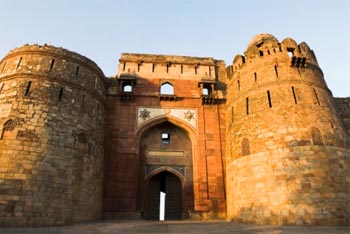
It was supposed to be a literary trip, full of known and lesser known facts and musings about a famous monument, or so we thought, but with every nook and corner of the magnificent Old Fort (Purana Quila) playing host to lovelorn or rather lustlorn couples, the trip turned out to be quite an eclectic mix of history, adventure, and mixed architecture, with a rather generous dash of present day romance thrown in.
The Delhi Diary had been long overdue in our unplanned travel itinerary, so when the plan finally hit the road, we thought that why not start off with the Old Fort, one of the most magnificent and oldest monuments in Delhi.
So armed with a sense of achievement at finally setting out on our wanderlust mission, we arrived at the Old Fort, on a positively cloudy day. I say "positively cloudy" because there are days when an overcast sky paints a very gloomy picture and gives us a sense of foreboding...But here was a day, which was cloudy in a very romantic way, with light drizzle welcoming you to explore the world...and the serenity of the fort quite overwhelming us and adding to the mystic charm of the landscape.
On approaching the Old Fort from the western side, the huge Bara Darwaza welcomes you with its stoic presence, giving nothing away of the huge architectural treasure inside, and revealing nothing of the imposing personality of the fort it guards. The Old Fort has three gates ' Humayun Darwaza, Talaqi Darwaza and the Bada Darwaza ' but now only the Bara Darwaza is used as the functional entrance to this massive monument. All these gates are double storeyed and in their heydays sported intricately designed domes. The fourth side of the fort was well guarded by a moat linked to the river Yamuna. The moat still exists, and runs along the huge expanse of the fort.
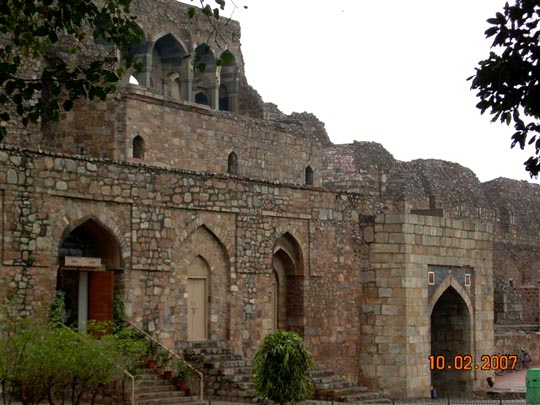
Humayun Darwaza
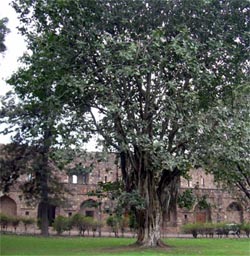 Once inside, the first thing that captures your eyes is the huge expanse of greenery - well grafted lawns, beautifully maintained flower beds and rows of lovely palms'. leaving us mesmerized, the serenity of the place unknowingly starts permeating us. The welcoming and enchanting environs encourage us to take out our cameras, and a flurry clicks follow. There are the beautiful peripheral walls to be captured, the lovely flowerbeds, and the ancient looking peepal tree and what not. But even in all this excitement of framing the world around you, serenity still lingers around'. tugging at us, reminding us of its presence.
Once inside, the first thing that captures your eyes is the huge expanse of greenery - well grafted lawns, beautifully maintained flower beds and rows of lovely palms'. leaving us mesmerized, the serenity of the place unknowingly starts permeating us. The welcoming and enchanting environs encourage us to take out our cameras, and a flurry clicks follow. There are the beautiful peripheral walls to be captured, the lovely flowerbeds, and the ancient looking peepal tree and what not. But even in all this excitement of framing the world around you, serenity still lingers around'. tugging at us, reminding us of its presence.
It is widely believed that the Pandavas (the famed warriors from the Mahabharata) had built their capital, Indraprastha at the place where the Old Fort stands today.
Situated towards the south of Delhi, this imposing fort was built in the 16th century, by King Sher Shah Suri, the founder of Sur Dynasty. In about 1539-40, Sher Shah Suri defeated his archrival, Mughal emperor Humayun, in two consecutive battles and captured two Mughal strongholds - Delhi and Agra. After setting up his reign, Shah Suri started constructing this enormous citadel to defend his most prized possession, Delhi, from the Mughals. Though the fort did not see any major battle event, its very existence kept the Mughals away from invading Delhi until 1545 when Sher Shah Suri died. And after his death, with the help of Persians, Humayun was able to re-capture Delhi and Agra. He then took upon himself the task of completing the construction of the Old Fort.
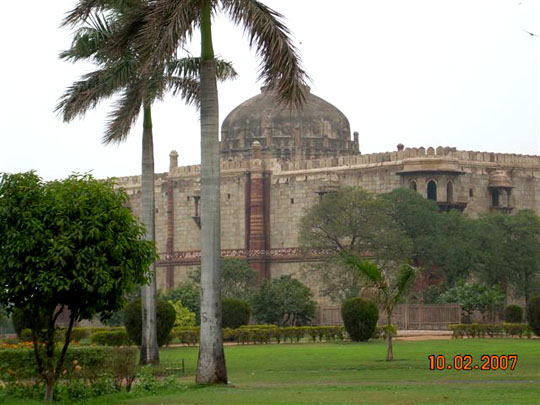
The Backside of the Quila-i-Kunha masjid
All the while we marveled at the amazing architecture of the place, the lovebirds completely ignored us and seemed determined to make the most of the time at hand. And then we chanced upon a beautiful inscription on a plaque, and probably this justified why there was love in the air, in a fort as colossal as this --- The inscription read '
'As long as there are people on this earth, may this edifice be frequented, and people are happy in it.'
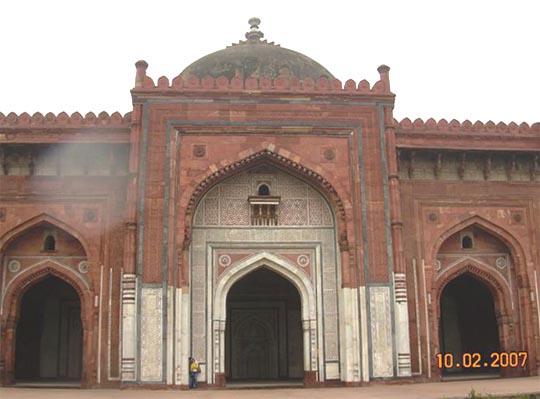
Front View of the Quila-i-Kunha Masjid
Inspiring.... Isn't it? So soaking in the architectural grandeur of the Qila-i-Kunha Masjid, we move on to the right southern side of the fort, wherein stands the Sher Mandal. History says that Sher Shah Suri built the Sher Mandal as a pleasure tower. It is an octagonal building made up of red sandstone. This two-storeyed structure has steep steps leading up to the roof. It is said that more storeys were supposed to be added to the Sher Mandal, but the idea was dropped due Sher Shah Suri's death. Later, when Humayun recaptured Delhi, he converted the Sher Mndal into his library and observatory Some Mughal documents indicate that it was while descending the stairs of this tower one day in 1556 that Humayun fell and received injuries from which he later died. Rumours exist that after his death, the Mughals considering the fort to be cursed, vacated the structure and built their capital in a new fort, which later came to be known as the Lal Qila, or the Red Fort.
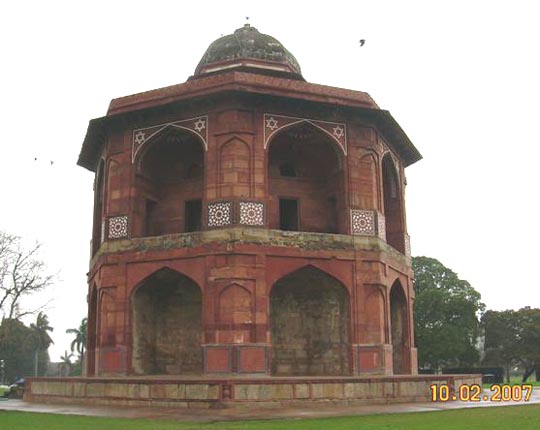
Sher Mandal
A leisurely walk around the peripheral walls of the fort finally brings to the building houses the archeological museum. The exhibits here comprise exhibits unearthed during excavations and dating back to the days of the Mughals, Sultans, Rajputs, Guptas, Kushan and Mauryas. The excavations here also revealed pieces of painted grey ware dating back to about 1000 BC, and is said to be related to Mahabharata, which confirm the beliefs that the Old Fort was built on the site of Indraprastha. The relics found here range from the Mauryan to early Mughal period such as Northern Black Polished Ware, punch-marked coins, human and animal terracotta figurines and inscribed terracotta seals.
So completely soaked in the stories of grand architectural and archaeological heritage of our country, we head back into the chaos of the city'. walking across the sprawling grounds of the mighty fort, with the many dramas staged here, silently playing out in our minds'. The distant echo of many a marching king and generals reverberating in our ears'With the drizzly weather still pleasantly egging us into joining the mad fray of city, we bid adieu to the serenity of the fort'And as the noble thought on the masjid proclaimed, 'As long as there are people on this earth, may this edifice be frequented, and people be happy in it', even we wish happiness for the world and its people, but more so for the couples inside! May they keep frequenting this edifice, and keep discovering moments of pure bliss, that is till their parents find out!
24-Feb-2007
More by : Ragini Puri

|
A minor correction is suggested. 'Quila-i-Kunha Masjid'. should be spelled as 'Quila-i-Kuhna Masjid'. The word '-Kuhna ' means ancient in Persian. So 'Quila-i-Kuhna Masjid' means the mosque of the ancient fort. |